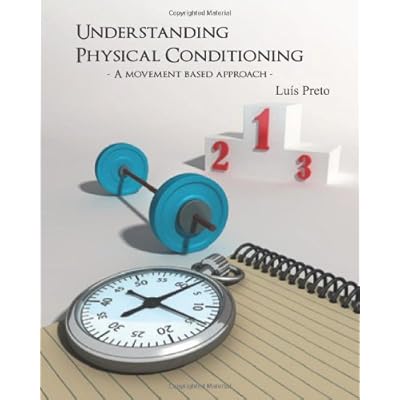This is the second book by Luis Preto I will be reviewing for the Dynamo blog and, let me tell you here that reading Luis' books is always a treat for me! I was quite impressed by his How to Sequence the Teaching of Technique and Tactics, a book about how to construct a sound curriculum for any martial art, and I am just as impressed (if not more) by his new book on physical conditioning for athletes, which is aptly titled Understanding Physical Conditioning - A Movement Based Approach.
OH MAN, ANOTHER BOOK ON PHYSICAL CONDITIONING... DO WE REALLY NEED IT?
Well, yes. I happen to own a great number of books on physical conditioning for sports and I have found most of them either too simplistic (little more than exercise prescriptions) or way too wordy, full of jargon and somewhat complex to actually apply in the gym. According to most of these books, an athlete needs to do resistance training in order to a) strengthen connective tissues, then b) increase muscle mass, then c) increase maximum strength, then d) increase explosive strength and finally e) convert to strength endurance, while simultaneously training to improve the body's ability to supply energy for repeating the activities her sport demands. Now add to these some range of motion training, plus some more training to prevent injuries and you are left with an algorithm of so many variables, that one inevitably has to wonder whether conditioning for athletes is actually way more complex that rocket science and quantum physics put together. Plus, if an athlete has to do so much conditioning work, is there any time in her life to practice technique and really participate in her chosen sport?
IS THIS BOOK ANY DIFFERENT THEN?
Oh, you bet! Preto starts the book by arguing that the common systematization of physical conditioning into the categories of strength, flexibility, speed and endurance is wrong, plus the all too common approach that has these physical abilities developed separately, in distinct training stages is short-sighted (yes, he actually uses this word). This way, the process of physical preparation for an athlete becomes necessarily complex and hard to manage. The argument is a very sound one, if you think about it: your skeletal muscles contract only in one way and depending upon the masses you have to move in your sport, you either want them to contract very fast and then relax or maintain the contraction for a little longer. So, the idea of training first for maximum strength, then explosive strength, then speed is actually absurd!
Let's follow this train of thought to the next station: when one muscle (or muscle group) is contracting on order to cause movement around a joint, the antagonistic muscle(s) are being stretched. In this sense, strength training, if performed in full range of motion, can make specialized mobility training sessions redundant or, in the worst case scenario, can help the athlete save lots of time by reducing the number of mobility exercises needed.
Now, let's take this logic one step further: if endurance training is necessary for one's, why spend hours at the track, when the athlete can build all the endurance he needs practicing sport-specific skills at the same time? This view is also endorsed by very successful MMA conditioning coach Joel Jamieson, who claims that cardiac output training does not necessarily have to be slow, long-distance running, but it can also be shadow boxing, bag or pad-work, performed in the 130-150 bpm heart rate zone - you train technique and endurance at the same time, thus saving time!
In the end, the complex algorithm of an athlete's physical preparation, says Preto, boils down to a two-factor training system, which can easily be managed if one follows the guidelines explained in the fourth section of this book. Athletes don't want to spend hour after hour in the weight room or the track - they want to play. In my opinion Preto's approach, allows for this delicate balance between physical preparation and tactical/technical training that makes a successful athlete.
ANY GOOD PROGRAMS INCLUDED IN THE BOOK?
Here's the bad news: according to Luis Preto, people who claim to have one-size-fits-all and easy-to-follow training recipes either have not done their homework, don't know what they're talking about or are simply trying to sell something. The good news is that if you study Preto's book and follow the guidelines provided, you will be able to design training programs yourself.
ANYTHING ELSE WORTH MENTIONING ABOUT THE BOOK?
Wow, where do I start? There's a number of training myths debunked in here, case studies of maverick athletes and coaches and there's also the point where Luis accuses some sport scientists of intellectual laziness or cowardice!What is there NOT to love about it? Oh, I almost forgot: at the end of each chapter Luis provides a series of questions, so that readers can test their understanding of what they read and flex their intellectual muscles.
HOW ABOUT THINGS I DIDN'T LIKE IN THE BOOK?
The layout could be a bit better and I would appreciate more tables and diagrams to visualize the knowledge.
ALL IN ALL?
I would say this is one of the most important books I have ever read on physical conditioning and I have read many. If you want to understand the way your body generates and fuels movement, the adaptations various training stimuli promote and how to organize those in training programs in order to improve athletic movement , you need to get a copy of this one! As usual, knowing the 'why' before the 'how' can make all the difference in the world.
HOW TO GET THE BOOK
You can purchase it from the Create Space self-publishing platform and Amazon online bookstores.
OH MAN, ANOTHER BOOK ON PHYSICAL CONDITIONING... DO WE REALLY NEED IT?
Well, yes. I happen to own a great number of books on physical conditioning for sports and I have found most of them either too simplistic (little more than exercise prescriptions) or way too wordy, full of jargon and somewhat complex to actually apply in the gym. According to most of these books, an athlete needs to do resistance training in order to a) strengthen connective tissues, then b) increase muscle mass, then c) increase maximum strength, then d) increase explosive strength and finally e) convert to strength endurance, while simultaneously training to improve the body's ability to supply energy for repeating the activities her sport demands. Now add to these some range of motion training, plus some more training to prevent injuries and you are left with an algorithm of so many variables, that one inevitably has to wonder whether conditioning for athletes is actually way more complex that rocket science and quantum physics put together. Plus, if an athlete has to do so much conditioning work, is there any time in her life to practice technique and really participate in her chosen sport?
IS THIS BOOK ANY DIFFERENT THEN?
Oh, you bet! Preto starts the book by arguing that the common systematization of physical conditioning into the categories of strength, flexibility, speed and endurance is wrong, plus the all too common approach that has these physical abilities developed separately, in distinct training stages is short-sighted (yes, he actually uses this word). This way, the process of physical preparation for an athlete becomes necessarily complex and hard to manage. The argument is a very sound one, if you think about it: your skeletal muscles contract only in one way and depending upon the masses you have to move in your sport, you either want them to contract very fast and then relax or maintain the contraction for a little longer. So, the idea of training first for maximum strength, then explosive strength, then speed is actually absurd!
Let's follow this train of thought to the next station: when one muscle (or muscle group) is contracting on order to cause movement around a joint, the antagonistic muscle(s) are being stretched. In this sense, strength training, if performed in full range of motion, can make specialized mobility training sessions redundant or, in the worst case scenario, can help the athlete save lots of time by reducing the number of mobility exercises needed.
Now, let's take this logic one step further: if endurance training is necessary for one's, why spend hours at the track, when the athlete can build all the endurance he needs practicing sport-specific skills at the same time? This view is also endorsed by very successful MMA conditioning coach Joel Jamieson, who claims that cardiac output training does not necessarily have to be slow, long-distance running, but it can also be shadow boxing, bag or pad-work, performed in the 130-150 bpm heart rate zone - you train technique and endurance at the same time, thus saving time!
In the end, the complex algorithm of an athlete's physical preparation, says Preto, boils down to a two-factor training system, which can easily be managed if one follows the guidelines explained in the fourth section of this book. Athletes don't want to spend hour after hour in the weight room or the track - they want to play. In my opinion Preto's approach, allows for this delicate balance between physical preparation and tactical/technical training that makes a successful athlete.
ANY GOOD PROGRAMS INCLUDED IN THE BOOK?
Here's the bad news: according to Luis Preto, people who claim to have one-size-fits-all and easy-to-follow training recipes either have not done their homework, don't know what they're talking about or are simply trying to sell something. The good news is that if you study Preto's book and follow the guidelines provided, you will be able to design training programs yourself.
ANYTHING ELSE WORTH MENTIONING ABOUT THE BOOK?
Wow, where do I start? There's a number of training myths debunked in here, case studies of maverick athletes and coaches and there's also the point where Luis accuses some sport scientists of intellectual laziness or cowardice!What is there NOT to love about it? Oh, I almost forgot: at the end of each chapter Luis provides a series of questions, so that readers can test their understanding of what they read and flex their intellectual muscles.
HOW ABOUT THINGS I DIDN'T LIKE IN THE BOOK?
The layout could be a bit better and I would appreciate more tables and diagrams to visualize the knowledge.
ALL IN ALL?
I would say this is one of the most important books I have ever read on physical conditioning and I have read many. If you want to understand the way your body generates and fuels movement, the adaptations various training stimuli promote and how to organize those in training programs in order to improve athletic movement , you need to get a copy of this one! As usual, knowing the 'why' before the 'how' can make all the difference in the world.
HOW TO GET THE BOOK
You can purchase it from the Create Space self-publishing platform and Amazon online bookstores.




No comments:
Post a Comment